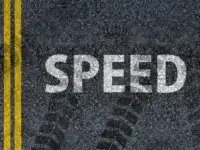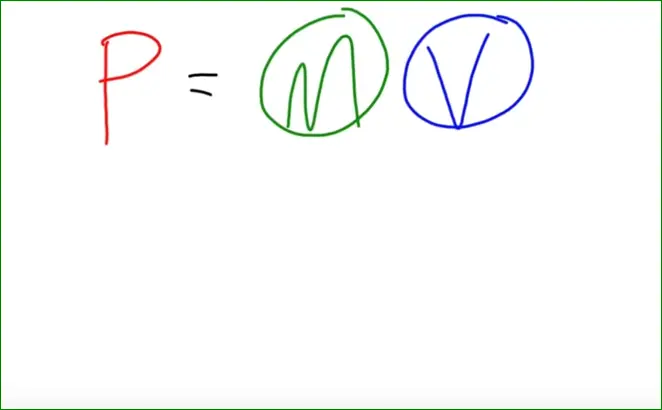Speed, velocity, and acceleration are not identical, but they are closely related. Each is a measure of an object’s movement through space and time, and can be calculated as an average or as the instantaneous value of a derivative function. Speed measures the rate at which an object moves through space, but gives no direction; velocity is simply speed plus direction. Acceleration is related to velocity in that it quantifies the change of an object’s velocity over time.

What is speed?
Speed (abbreviated v in equations) is defined as the distance an object moves over time. Both distance and time are values with magnitude, meaning they can be given as a single numerical value: five inches, ten seconds, and so on. Any measurement that has only magnitude is called a scalar quantity. Although scalar quantities can change, they have no direction in themselves, and – importantly – they are always positive values.
Speed is a derivative of distance (or position), meaning that it depends on (or is derived from) time. Speed is a meaningful concept only when both time and distance can be determined, as seen in the formulae used to calculate it.
The formula to calculate average speed is v = d/t or v = (d1-d0)/(t1-t0), where d is distance and t is elapsed time. If an object moves fifteen miles over the course of two hours, its speed is 15 miles/2 hours, or 7.5 miles per hour. This equation gives an object’s average speed over the course of t1-t0, but its instantaneous speed – its speed at any given instant during t1-t0, is a function, not a value.
The function for an object’s instantaneous speed can be written in several different ways: one simple way to write it would be vi=dx/dt, using standard calculus notation. In this equation, x is position and t is time, while the letter d signifies a derivative function. Derivative functions are used in calculus to quantify changing variables in time.
The simplest way to conceptualize this is to imagine an object’s average speed as a point somewhere on an x-y axis, where time is on the x-axis. The object’s actual speed would be a line, and the shape of its slope would describe how its speed changes over time. A derivative function will give as close an approximation as mathematically possible to the exact point on that line at a given time.

What is velocity?
Velocity (also abbreviated v) is speed with direction. It is also defined as an object’s change of position over time. Velocity is a vector quantity, meaning magnitude alone can’t define it completely. Vector quantities, unlike scalar quantities, can be negative – an object’s speed can never be negative, but its velocity can.
Like speed, velocity is a derivative of position in time; the difference is in how position is recorded. Distance, as it is reported in physics, is directionless – but position is not. The tip of a clock’s second hand never changes its distance from the center, even as its position changes continually. Thus, the speed of the second hand is constant, but its velocity is continuously changing.
Velocity is calculated in different ways, using different equations. The simplest of these is the equation for average velocity:
v = (r1-r0)/(t1-t0)
where r is position and t is time. It is almost the same as the equation for average speed, with the distinction that r depends on direction as well as distance. The equation is sometimes written:
v = Δr/Δt
Which is another way of saying the same thing: Δ means “change.” The instantaneous velocity is the derivative function:
v(t) = dr/dt
Which is nearly the same as the equation for instantaneous speed. In derivative functions, the numerator on the right side of the equation is analogous to a dependent variable, and the denominator is the independent variable. The difference between the speed and velocity equations is that the dependent variable is different: distance in the first case, position in the second.

What is acceleration?
Acceleration is defined as the change in an object’s velocity (or speed) over time. It is a derivative of velocity, just as velocity is a derivative of an object’s position. Since it is a vector quantity, it can be negative (this is commonly called deceleration). Note that although acceleration is commonly used in reference to speed only, any change in velocity (including no change) constitutes acceleration – so an object moving at a constant speed in a straight line has an acceleration of zero, but any change in direction constitutes acceleration.
Acceleration is different from speed and velocity because it is a second-order derivative, meaning that it is a derivative of a derivative. Put simply, velocity measures change in position over time, while acceleration measures change in the change in position over time. It is therefore expressed in compound units: for example, meters per second per second, or m/s/s.
Like speed and velocity, acceleration can be average or instantaneous, and the formulae are similar:
a=(r1-r0)/(t1-t0) for average acceleration, and
a(t) = dv/dt for instantaneous.
The difference is the term v, which stands for velocity.
Similarities Between Speed, Velocity, and Acceleration
All three of these quantities are derivatives of position in space, meaning they express the change in an object’s position (i.e., movement) over time. All three may be calculated as averages over a given time or as instantaneous values satisfying a derivative function.
Similarities Between Speed and Velocity
Both speed and velocity are first-order derivatives of position, meaning they are both related to a change in position over time. Their equations, both average and instantaneous, are the same: v = d/t and v=dx/dt, respectively.
Similarities Between Velocity and Acceleration
Acceleration is related to velocity through derivation: it is a change in an object’s velocity over time. As velocity changes, acceleration changes as well. Both velocity and acceleration are vector quantities, as opposed to speed, which is a scalar quantity, meaning that they are directional.
FAQ
Q: What are the similarities between speed, velocity and acceleration?
A: Speed, velocity and acceleration are all elements of kinematics, the branch of physics that deals with the motion of bodies in space. All three are different ways of describing an object’s changing position over time, and are derivatives of position in time.
Q: What are the similarities between speed and velocity?
A: velocity and speed both describe the rate at which an object changes position over time. By definition, velocity is also speed, and an object with constant velocity necessarily has a common speed as well.
Q: What are the similarities and differences between average velocity and acceleration?
A: Average velocity and acceleration are both ways of describing an object’s change in position and direction over time; both are therefore vector quantities. However, acceleration is a derivative of velocity: calculating acceleration requires that velocity is known at the start and end time, while velocity only requires known position. There is a sense in which the difference is analogous to
Q: What are the similarities and differences between average velocity and average speed?
A: Both quantities are given as single values, and calculated via the same equation: v = (r1-r0)/(t1-t0), where r0 is starting position, r1 is ending position, t0 is start time, and t1 is ending time.Both therefore express a change in position over time, but not a rate of change. Both are precise in inverse proportion to the difference between start and end time: as the difference approaches zero, precision increases.
Q: Why would speed and velocity be the same?
A: The answer depends on how both are measured and calculated. Speed and velocity may be identical if the direction of travel is in a straight line perpendicular to the reference, and the instantaneous speed of an object will momentarily equal its average velocity (and vice versa) at some point. More trivially, an object at rest has identical speed and velocity – zero.
Q: Are speed and velocity always the same?
A: No. While they are used interchangeably, they are not measured or expressed in the same terms. The only time speed and velocity are the same is when an object is traveling in a straight line away from the reference (or when it is at rest).












Leave a Reply